Chapter 3: The Classical Reborn
The term Renaissance is very widely known, although its significance is often murkily understood. Primarily, the term refers to groundbreaking Italian and Northern European art which, in the 14th and 15th century, broke from the “Byzantine” tradition of the medieval Church “in favor of the revival of the culture of ancient Greece and Rome” (Renaissance). In 1550, a book of art history first used the term rinascita, or rebirth to characterize an era of immense influence. Giorgio Vasari, an Italian painter and architect, named and mapped the age of the Renaissance in a book known in English as The Lives of the Artists.
Vasari’s The Lives of the Artists (1550)
The fuel that powered the Renaissance was money. In the 14th Century, Europe was transformed by commerce. International trade imported spices and silks from Asia, but sophisticated textile industries were emerging in Northern Europe and Italy. Trade centers like Florence, Venice, and Pisa developed the beginnings of modern financial tools such as bookkeeping, insurance, and international corporations. Europe’s emerging wealth was primarily centered in two areas:
- Italy, especially Venice, trading hub connecting Europe to Asian spices and silks
- The Low countries of Northern Europe, Flanders[1] and Holland, trading hubs for the Black sea and purveyors of magnificent fabrics
Guess which two regions of Europe dominated the Renaissance. Yep! Italy and the Low Countries of the North funded the spectacular achievements of their best artists.
[1] Flanders is today the northern districts of Belgium. In Medieval times, it included parts of what we know today as The Netherlands and France. Note: The Netherlands were split into Belgium (Catholic) and Holland (Reformed) by the Reformation.
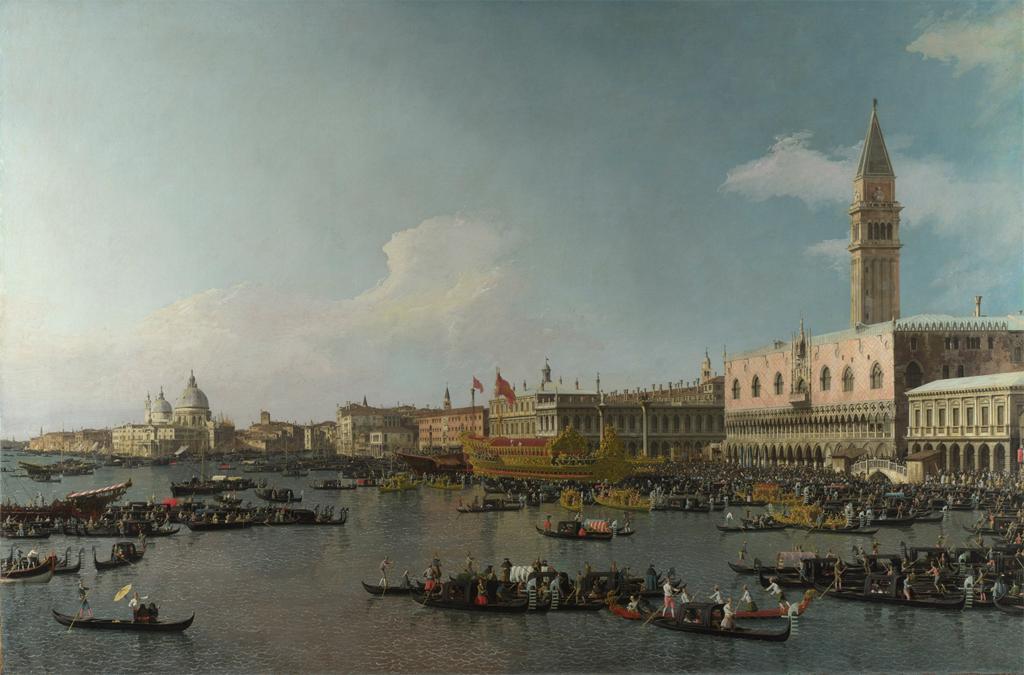 |
| Canaletto. (c. 1740). Venice: The Basin of San Marco on Ascension Day. Oil on Canvas. |
A great deal of this wealth was held by the Church, and bishops and popes continued to patronize art. However, after nearly 1,000 years in which the church virtually monopolized the work of artists, Renaissance era private capital began to commission work with more secular orientations. Last week, we said that the Greco-Roman tradition of Portraiture was suspended during the Byzantine era. In the 14th Century, private persons began to commission artists to commemorate them in paint. In Germany, the painter Lucas Cranach the Elder made a career out of the portraits of wealthy patrons such as Dr. Johannes and Anna Cuspinian (1502).
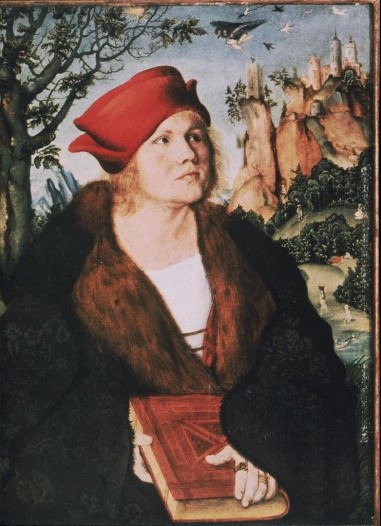 |
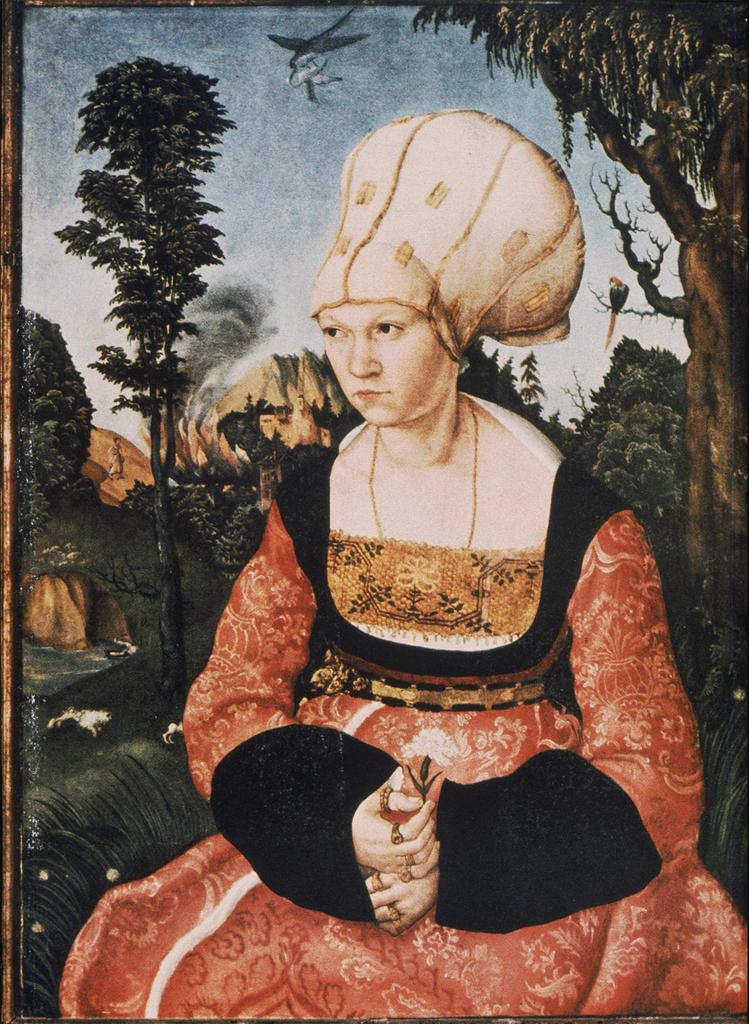 |
| Portrait of Dr. Johannes Cuspinian. Tempera on wood. | Portrait of Anna Cuspinian. Tempera on wood. |
While private wealth expanded the range of artistic subjects, Christian themes still dominated. Wealthy patrons often commissioned art for Churches. But the subjects were transformed by their interests. Backgrounds for biblical scenes reflected contemporary lands and palaces and onlookers at a biblical event were likely to be dressed in the latest European fashions. Indeed, the faces of the figures were likely to be those of the patrons! In 1478, the Florentine artist Sandro Botticelli painted a biblical standard (generic) biblical scene, one very common in church art. The Adoration of the Magi celebrates the moment when 3 Magi (sages) visit and venerate the infant Jesus in his manger (Matthew 2.1-12). Painted into the scene in the lower left are members of the vastly wealthy Medici family, Botticelli’s patrons.
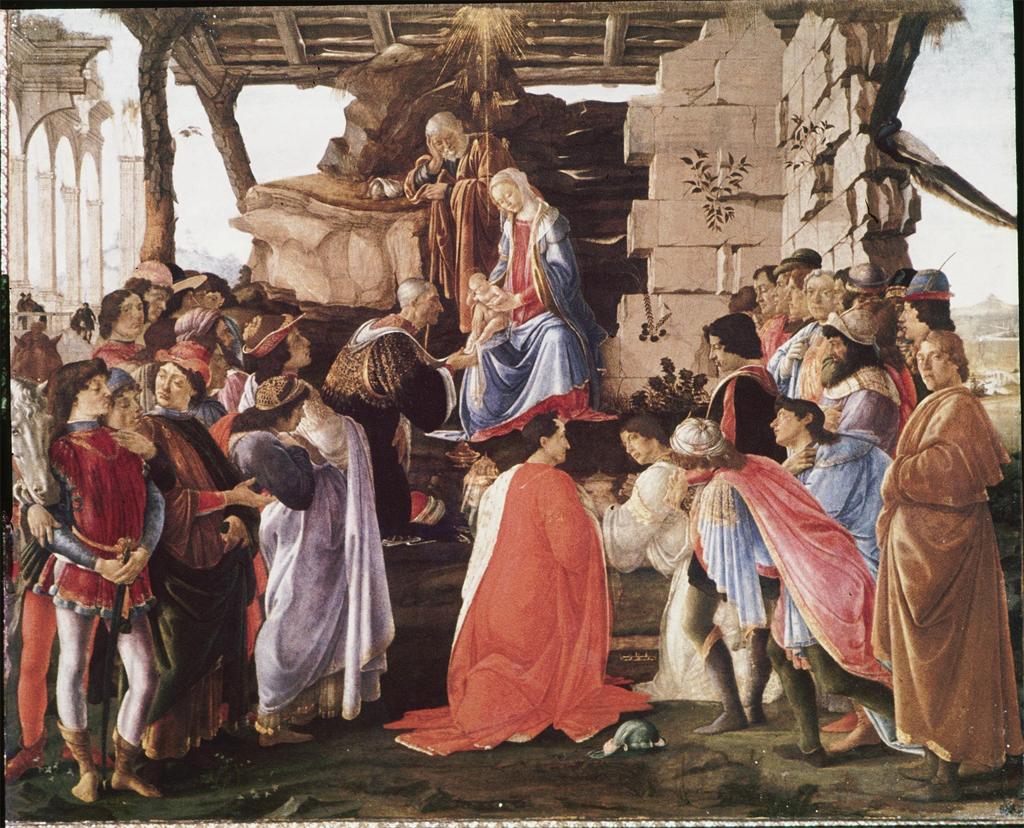 |
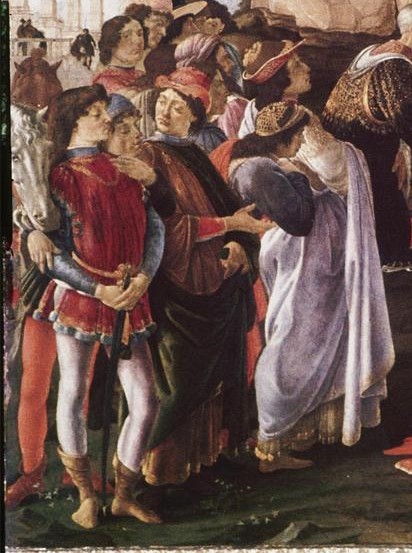 |
|
| The Adoration of the Magi. (1478). Tempera on panel. | Medici patrons (Detail 1) | Botticelli’s self-portrait (Detail 2) |
But who is that figure looking impassively out at the viewer (Detail 2). Why, that is Botticelli himself, a self-portrait blended slyly into the holy scene. Botticelli’s presence in the painting signifies a major shift in cultural values. During the long centuries of the early Middle Ages, artists worked anonymously for the church. No one knows who designed most Medieval great churches or carved the magnificent friezes above the portals. Artists’ identities as creative individuals were erased in a culture that honored only aristocratic lords and ladies and exalted members of the clergy: bishops, abbots, etc. During the Renaissance, artists began to earn reputations and, if they were good enough, fortunes. The identity of the artist gained a stature sufficient to justify self-portraits. Botticelli’s embedded self-portrait typifies a vogue among Renaissance painters. Look closely and you’ll see in many post Renaissance paintings small portraits of the artist gazing into viewers’ eyes. Some began to paint self-portraits as standalone works. Here we see the flamboyant German master Albrecht Dürer.
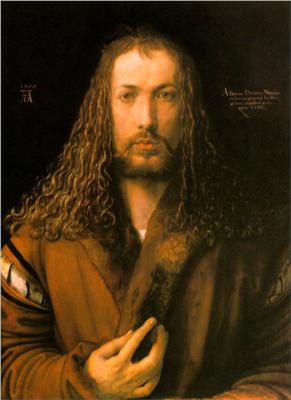 |
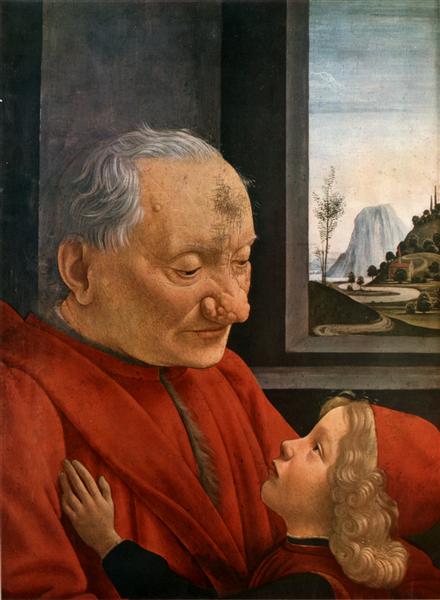 |
 |
| Albrecht Dürer. (1500). Self-portrait in a fur-trimmed coat. Oil on limewood | Domenico Ghirlandaio (1490) Old Man with a Young Boy. Tempera on Wood. | Rembrandt van Rijn (1661) Self-portrait with palette and brushes. Oil on canvas. |
Imagine yourself as a portrait painter hired to commemorate a family member. Consider your dilemma: on the one hand, you need to flatter your patrons, to make them look as good as possible. On the other hand, you need to make their images recognizable. Frequently, facial “flaws” comprise a good deal of our visual identity. Sometimes, paintings strive to achieve Aesthetic effects other than beauty. Or, perhaps, a deeper idea of beauty. Ghirlandaio’s portrait of a grandfather frankly presents a homely, aging face marked by signs of decay. These visual defects contrast with the angelic beauty of a child. We might see the love passing between old man and child transcending physical flaws in a spiritual beauty. Rembrandt van Rijn, the great Dutch artist, painted many self-portraits. Rather than indulging in self-flattery, however, he ruthlessly explores the inner and outer truths of his face. In this famous self-portrait, he pitilessly examines signs of age and decay: his mortality.
References
Botticelli, S. (1475). The Adoration of the Magi. [Painting]. Florence: Uffizi Gallery. ARTstor https://library-artstor-org.ezproxy.bethel.edu/asset/ARTSTOR_103_41822000464600.
Canaletto. (c. 1740). Venice: The Basin of San Marco on Ascension Day. [Painting]. London: National Gallery. ARTstor https://library-artstor-org.ezproxy.bethel.edu/asset/ANGLIG_10313767392.
Cranach, Lucas the Elder. (c.1502-3). Anna Cuspinian. [Painting]. ARTstor https://library-artstor-org.ezproxy.bethel.edu/asset/ARTSTOR_103_41822000873958.
Cranach, Lucas the Elder. (c.1502-3). Dr. Johannes Cuspinian. [Painting]. ARTstor https://library-artstor-org.ezproxy.bethel.edu/asset/ARTSTOR_103_41822000873941.
Durer, A. (1500). Self-portrait in a fur-trimmed coat. [Painting]. Munich, Germany: ALte Pinakotech. ARTstor https://library-artstor-org.ezproxy.bethel.edu/asset/ARTSTOR_103_41822000655819.
Ghirlandaio, Domenico. (1490). Old Man with a Young Boy. [Painting]. Paris, France: Louvre Museum. Wikiart https://www.wikiart.org/en/domenico-ghirlandaio/old-man-with-a-young-boy.
Vasari, Giorgio. [Article]. (2003). In Campbell, G. (Ed.), The Oxford Dictionary of the Renaissance. https://www.oxfordreference.com/view/10.1093/acref/9780198601753.001.0001/acref-9780198601753-e-3612.
Rembrandt van Rijn. (1661). Self-portrait with palette and brushes. [Painting]. https://library.artstor.org/asset/ARTSTOR_103_41822000702900.
Renaissance. [Article]. (2003). Campbell, G. (Ed.), The Oxford Dictionary of the Renaissance. Oxford University Press. https://www.oxfordreference.com/view/10.1093/acref/9780198601753.001.0001/acref-9780198601753-e-3013.
a pervasively influential era in 15th and 16th century Europe marked by a Renaissance—or rebirth—of interest in and knowledge of classical Greek learning through humanist scholarship that challenged medieval values. In painting and sculpture, the work of artists in Italy, Germany, and the Low Countries which broke with Byzantine conventions to explore the geometry of perception and locate images and actions in time and space.
the art of representing the physical or psychological likeness of an individual in painting, drawing, sculpture, and photography (Portraiture).
